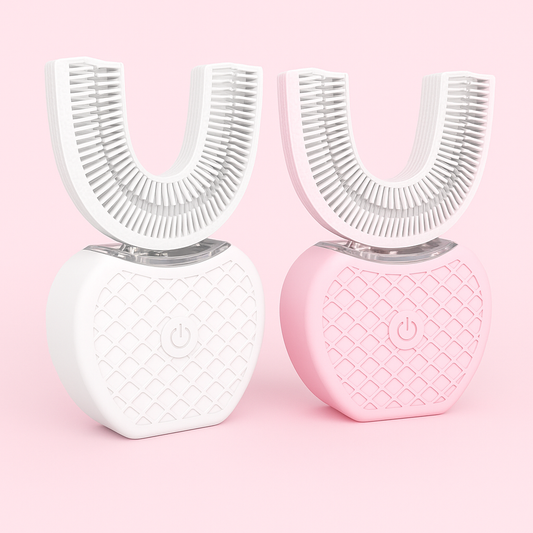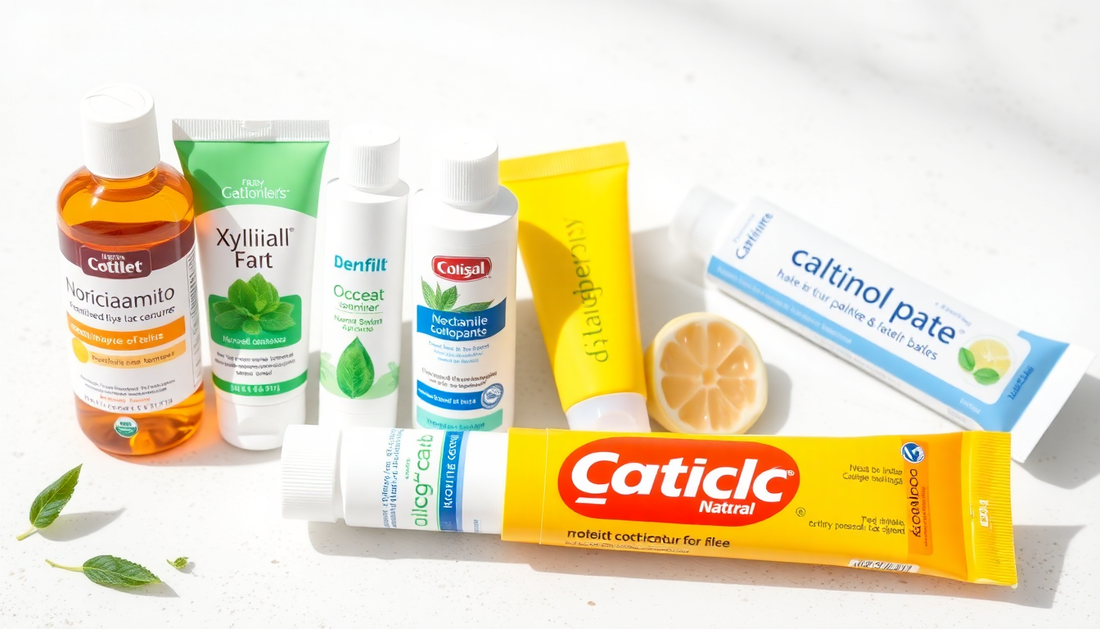Introduction: Why this checklist matters
Searching for a toothpaste that whitens but avoids fluoride? Youre not alone. More consumers seek fluoride-free options that rely on ingredients like niacinamide and xylitol to support oral health while improving appearance. This extended buyers lab guide walks you through the science, the ingredients, the red flags, and a rigorous step-by-step buying and testing workflow so you can choose an effective, safe toothpaste for healthier, whiter teeth.
Quick primer: How tooth staining and whitening actually work
- Extrinsic stains: Surface stains from coffee, tea, red wine, tobacco, and foods. These are the easiest to address with abrasive particles, enzymes, or optical agents that alter light reflection.
- Intrinsic stains: Deep discoloration inside the tooth dentin from aging, trauma, medications, or fluorosis. These often require professional whitening (peroxide-based) or restorative treatments.
- Whitening mechanisms: Abrasion (physically removes stain), chemical bleaching (peroxides oxidize pigments), enzymatic breakdown (digest stain proteins), optical effects (blue pigments/coat to make teeth appear whiter), and remineralization strategies that can make enamel smoother and appear brighter.
Key ingredients explained: Niacinamide, Xylitol, and what actually whitens
-
Niacinamide (vitamin B3)
- Primary role in oral care: anti-inflammatory and barrier-supporting properties that may soothe gum tissues and support mucosal health.
- Whitening role: indirect at best. Niacinamide contributes to a healthier oral environment and may reduce redness and staining associated with inflammation, but it is not a chemical bleaching agent.
-
Xylitol
- Mechanism: a sugar alcohol that reduces cariogenic bacteria adherence and acid production. It supports fewer cavities and better microbiome balance.
- Whitening role: indirect. By lowering biofilm levels and creating a healthier mouth, xylitol can reduce new staining and improve the appearance of teeth over time.
-
Abrasives
- Common abrasives: hydrated silica, calcium carbonate, baking soda. These remove surface stains but vary in abrasivity.
- Key measure: Relative Dentin Abrasivity (RDA). Daily toothpastes should generally have RDA values under ~100 to avoid long-term enamel/dentin wear.
-
Peroxide (hydrogen or carbamide)
- Powerful bleaching agents used in professional or some over-the-counter whitening products. Rarely found in fluoride-free daily toothpastes because of stability and irritation concerns.
-
Hydroxyapatite and CPP-ACP
- Fluoride alternatives that support remineralization and can reduce sensitivity. Nano-hydroxyapatite may help surface smoothness and optical brightness.
-
Enzymes and optical agents
- Enzymes (e.g., papain, bromelain) help break down organic stains. Optical agents like blue covarine create an instantaneous perception of whiteness by shifting reflected light.
Understanding formulation parameters that impact effectiveness and safety
-
Relative Dentin Abrasivity (RDA)
- RDA quantifies abrasive potential. Low-RDA formulas are gentler but may remove stains more slowly. High-RDA formulas might whiten faster but risk enamel loss and sensitivity over time.
- How to use RDA: prioritize transparency. If RDA is not listed, search manufacturer or third-party testing reports, or choose a brand that provides this metric.
-
pH of the toothpaste
- Neutral to slightly alkaline formulations (pH ~6.58.5) are preferred. Acidic formulas can soften enamel, making stains more likely and increasing erosion risk.
-
Surfactants and foaming agents
- SLS (sodium lauryl sulfate) is common but can irritate some users and aggravate canker sores. If you are sensitive, look for SLS-free alternatives.
-
Humectants, binders and preservatives
- Humectants (glycerin, sorbitol) prevent drying. Binders (xanthan gum, carbomers) maintain texture. Preservatives (sodium benzoate, phenoxyethanol) maintain shelf-life. Check for known irritants if you have allergies.
The detailed buyers lab checklist: step-by-step evaluation
Approach each toothpaste as if you were testing it in a lab. This section expands the checklist into practical steps you can use online or in-store.
-
Ingredient transparency and label reading
- Demand a full ingredient list on the product page or packaging. If the brand hides details, move on.
- Look for percentages or mg amounts for key actives like xylitol or niacinamide. Brands that provide concentrations are generally more trustworthy.
- Check for alternative anti-caries actives (nano-hydroxyapatite or CPP-ACP) when fluoride is absent.
-
Claim verification and evidence
- Search for human clinical trials, peer-reviewed publications, or third-party laboratory reports. Evaluate sample size, duration, and endpoints (shade change, sensitivity, plaque reduction).
- Be skeptical of ambiguous claims like 'clinically proven' without citations.
-
Assess abrasivity and enamel safety
- Prefer RDA information. If unavailable, look for descriptive language: 'low-abrasion', 'gentle', or 'for daily use' and corroborate with independent reviews.
-
Evaluate anti-caries strategy in fluoride-free formulas
- Confirm xylitol is present and listed as an active. Also look for calcium/phosphate systems that aid remineralization.
-
Check pH and stabilizers
- Neutral or slightly alkaline pH supports enamel. Stabilizers that preserve active ingredients (antioxidants or chelators) can extend efficacy.
-
Flavor, foaming and irritants
- For sensitive mouths, pick SLS-free, alcohol-free formulas. Watch for strong cinnamon or peppermint flavors if you have mucosal sensitivity.
-
Packaging and shelf life
- Opaque tubes reduce light exposure to sensitive actives. Airtight caps and short ingredient lists indicate thoughtful formulation.
-
Third-party endorsements and manufacturing quality
- Look for GMP manufacturing claims, ISO certifications, and independent lab testing. Certification logos should link to verifiable statements.
-
Price, sample sizes and trial options
- Compare cost-per-mL and the presence of trial or travel sizes. A trial makes it easier to test whitening outcomes and sensitivity without committing to a full tube.
How to run an at-home lab test: tracking whitening and safety over time
After buying a candidate toothpaste, use consistent, measurable methods to judge performance.
-
Baseline documentation
- Take high-resolution photos in natural light against a neutral background. Use the same camera, same angle, and include a color reference (a white card) in each photo.
- If possible, use a dental shade guide to record your starting shade.
-
Weekly monitoring protocol
- Photograph once per week for 8 weeks, at the same time of day. Record any sensitivity, gum changes, or texture differences.
- Keep a short daily log of dietary exposure to staining compounds and any deviations from your normal oral routine.
-
Sensitivity check
- Note any increases in cold or hot sensitivity. If sensitivity rises significantly within the first 14 weeks, stop use and consult a dental professional.
-
Plaque and gum health
- Use disclosed plaque tablets (or food coloring) weekly to see how well the toothpaste reduces biofilm accumulation. Record gum appearance and bleeding on brushing.
Routine and technique to maximize whitening and safety
- Use a soft-bristled toothbrush and gentle, circular strokes. Overvigorous brushing accelerates abrasion-related wear.
- Brush twice daily for two minutes. If you use acidic foods or drinks (citrus, soda), wait 3060 minutes before brushing to avoid brushing softened enamel.
- Floss daily and consider an antiseptic rinse for short-term plaque control, but be aware that some rinses (chlorhexidine) can cause staining with prolonged use.
- Pair a niacinamidexylitol toothpaste with mechanical stain removal (toothbrush, prophylaxis) for best visible outcomes.
Alternatives to fluoride and when they make sense
- Nano-hydroxyapatite: Restores mineral content and can reduce sensitivity; shows promise as a fluoride alternative.
- CPP-ACP (casein phosphopeptide-amorphous calcium phosphate): Supports remineralization and enamel repair; often included in fluoride-free therapeutic formulas.
- Niacinamide and xylitol together: Complement each other for mucosal comfort and microbial control but should be seen as supportive, not primary whitening agents.
Red flags and marketing traps
- Vague terms: 'natural whitening', 'detox', or 'cleanses stains' with no data.
- Unsubstantiated timelines: 'whiter in 3 days' or 'instant whitening' without clear mechanism or studies.
- Hiding concentrations: brands that don't disclose xylitol or niacinamide amounts may rely on marketing rather than efficacy.
- Overly abrasive formulations marketed as 'scrub' or 'heavy-duty' for daily use.
Where to buy and how to choose retailers
- Choose retailers that display full ingredient lists and allow customers to view third-party test results or clinical summaries.
- Buy trial sizes first when possible. Subscription models can be convenient but avoid long-term commitments until efficacy and tolerance are confirmed.
- For a curated selection of fluoride-free options that emphasize transparency and ingredient detail, visit Havana Bodys product pages: their listings include clear ingredient panels and consumer guidance on formulations like the best toothpaste for whiter teeth and toothpaste with xylitol.
Interpreting reviews and user photos
- Check for consistent results across many users rather than relying on a few dramatic before/after photos.
- Watch for lighting tricks: studio lighting and editing exaggerate whitening. Prefer natural light photos and reports that include timeframe details (4, 6, 8 weeks).
- Look for reviews that mention sensitivity and gum changes, not just shade improvements.
FAQ: Common questions consumers ask
-
Will niacinamide whiten my teeth?
Niacinamide supports gum and mucosal health and may indirectly improve appearance over time, but it is not a direct bleaching agent.
-
Is xylitol in toothpaste effective for preventing cavities?
Xylitol reduces growth of cariogenic bacteria and supports a healthier oral environment; its presence in toothpaste is beneficial, though therapeutic exposure in trials often involves xylitol gum or candy in addition to toothpaste.
-
Can I achieve professional-level whitening with toothpaste alone?
No. Toothpastes can remove surface stains and improve appearance gradually. For deeper, intrinsic stains and dramatic lightening, professional peroxide-based whitening is typically required.
-
What if Im avoiding fluoride for medical reasons?
Discuss with your dentist. Fluoride is a proven anti-caries agent, but alternatives (nano-hydroxyapatite, CPP-ACP, xylitol) can offer benefits when fluoride is intentionally excluded.
-
How long until I see results?
Surface stain reduction may be visible within 28 weeks, depending on stain severity, brushing technique, and formula abrasivity. Document results consistently to assess changes accurately.
SEO search strategy to find the best products
Use targeted queries combining ingredient and intent keywords to find suitable products and evidentiary pages. Examples: "toothpaste without fluoride xylitol niacinamide clinical", "best toothpaste whitening teeth fluoride free", "toothpaste with xylitol review". These searches help you locate formulary details and independent tests. If you want a convenient starting point with transparent product pages, check Havana Bodys selection for options described as toothpaste whitening best and toothpaste without fluoride.
Buying workflow summary: a practical five-step plan
- Filter products that list both xylitol and niacinamide and show full ingredient panels.
- Compare RDA, pH, and any available clinical or third-party lab data.
- Read broad user feedback focusing on both whitening and sensitivity outcomes.
- Purchase a trial size or travel tube and document baseline photos and observations.
- Test for 48 weeks, track changes, and consult your dentist if problems arise or if you want stronger whitening.
Final verdict: realistic expectations and long-term maintenance
Fluoride-free formulas that emphasize niacinamide and xylitol are a valid choice for people prioritizing gentler, anti-inflammatory, and anti-cariogenic strategies while seeking gradual surface stain reduction. Expect incremental improvements rather than immediate, dramatic whitening. For fast or deep whitening, discuss professional options with your dentist. Combining an appropriate toothpaste with good oral hygiene, dietary management, and routine dental care will produce the best long-term cosmetic and health results.
Sponsored recommendation and call to action
If youre ready to try carefully formulated fluoride-free options that prioritize niacinamide and xylitol with transparent ingredient listings, consider exploring Havana Bodys curated range. Their product pages present clear ingredient panels and consumer guidance to help you select the most suitable formulation for whitening and oral health. Start by reviewing their best toothpaste for whiter teeth picks or browse products tagged as toothpaste that whitens teeth and toothpaste with xylitol. Try a trial size, follow this buyers lab checklist, and evaluate results over 48 weeks. Ready to shop? Visit Havana Body to discover products tailored to healthier, whiter teeth and place an order today.
Closing note: when to see a dental professional
If you have significant intrinsic staining, active decay, persistent gum disease, or sudden sensitivity after changing products, stop use and consult your dentist promptly. Your dental professional can provide diagnosis, professional whitening options, and individualized recommendations for a fluoride-free oral care plan if needed.


